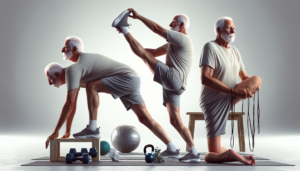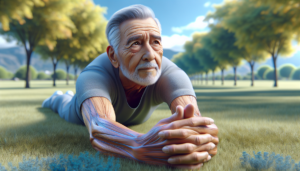Importance of Flexibility for Older Men
As older men age, maintaining flexibility becomes increasingly important. Flexibility plays a vital role in helping them remain limber and mobile as they navigate daily activities. Let’s explore the benefits of staying limber and understand the crucial role flexibility plays in daily movements.
Benefits of Remaining Limber
Remaining flexible offers a multitude of benefits for older men. One significant advantage is the enhanced range of motion it provides, allowing individuals to move more freely and comfortably. A flexible body with a greater range of motion in joints makes everyday movements easier and reduces stiffness in shoulders, back, and hips that can result from prolonged periods of sitting or looking at screens (SilverSneakers).
Additionally, improved flexibility can contribute to better posture, balance, and overall mobility. It can also help in activities like turning the head, reaching for items, improving golf swings, or simply dancing. Regular stretching for seniors has been shown to positively impact everyday movements, making them smoother and more effortless, ultimately enhancing the quality of life.
Role of Flexibility in Daily Movements
Flexibility plays a crucial role in the execution of daily movements for older men. As individuals age, maintaining flexibility aids in performing activities essential for daily living. Simple tasks such as bending down to tie shoelaces, reaching for items on high shelves, or getting in and out of chairs can become more challenging with decreased flexibility.
By incorporating stretching routines and flexibility exercises for older men into their daily regimen, men can improve their flexibility and range of motion, making these movements easier and less strenuous. Age-related changes, such as tight hamstrings, poor hip flexibility, and muscle-tendon stiffness, can be counteracted through targeted stretching exercises, leading to improved flexibility and mobility in aging individuals (Source).
Maintaining flexibility is not only beneficial for daily activities but also contributes to a higher quality of life as individuals age. Improvements in flexibility have been observed in older adults who engaged in strength and static stretching exercises, leading to enhanced flexibility in the posterior muscular chains. This emphasizes the importance of incorporating flexibility exercises into the fitness routine of older men to support joint health, reduce stiffness, and enhance overall mobility.
Fitness Activities for Senior Men
When it comes to addressing senior men’s flexibility challenges, incorporating a well-rounded fitness routine that focuses on enhancing flexibility and mobility is essential. Let’s explore three key fitness activities that can help senior men improve their joint health, reduce stiffness, and increase overall mobility.
Stretching and Yoga
Stretching: Engaging in regular stretching routines is crucial for maintaining flexibility and enhancing range of motion in the joints. Stretching exercises help to loosen tight muscles, improve circulation, and reduce the risk of injuries. Consider incorporating dynamic stretches to warm up before physical activity and static stretches to cool down and improve flexibility. For specific stretching routines tailored for seniors, check out our article on stretching routines for seniors.
Yoga: Yoga offers a blend of gentle stretching, strength building, and relaxation techniques that can benefit senior men in various ways. Practicing yoga regularly can help improve posture, balance, and flexibility. Additionally, yoga can promote relaxation and reduce stress levels, contributing to overall well-being. Explore different yoga poses and sequences designed for older individuals to enhance your flexibility and mobility.
Balance Exercises
Maintaining balance is crucial for preventing falls and enhancing mobility in senior men. Incorporating balance exercises into your fitness routine can help improve stability and coordination. Activities such as standing on one foot, walking heel-to-toe, or practicing tai chi or yoga can be particularly effective in enhancing balance and preventing falls (WebMD). For a comprehensive guide on exercises to boost balance, check out our article on senior men’s fitness tips.
Strength Training
Strength training plays a fundamental role in promoting muscle strength, bone density, and overall functional capacity in senior men. Aim to incorporate strength training exercises into your routine at least two days a week. Including activities such as lifting weights, using resistance bands, performing push-ups, and engaging in sit-ups can help maintain muscle mass and strength as you age (WebMD). For a structured strength training program tailored for older men, explore our senior male flexibility program.
By integrating stretching and yoga, balance exercises, and strength training into your fitness regimen, you can effectively address flexibility challenges and improve mobility as a senior male. Remember to consult with your healthcare provider before starting any new exercise program, especially if you have underlying health conditions or concerns. Stay committed to your fitness journey and prioritize your joint health and mobility for a more active and fulfilling lifestyle.
Considerations for Joint Health
As we age, maintaining flexibility and mobility becomes increasingly important for overall health and quality of life. For older men looking to improve joint health, reduce stiffness, and increase mobility, there are key considerations to keep in mind.
Gentle Joint-Friendly Exercises
When it comes to promoting joint health, engaging in gentle and joint-friendly exercises is crucial. As joints tend to weaken with age, it’s important to choose activities that help maintain flexibility without causing unnecessary strain. Opting for exercises that are low-impact and focus on range of motion can help improve joint flexibility and reduce the risk of injury.
Activities such as walking, swimming, and biking are excellent choices for seniors as they are gentle on the joints while promoting mobility. These exercises help keep the hips and knees working well, allowing for better overall movement and functionality as one ages. To discover a variety of flexibility exercises tailored specifically for older men, explore our senior male flexibility program.
Regular stretching is also beneficial for joint health, as it can improve everyday movements like turning the head, reaching for items, or even improving specific activities such as golf swings or dance moves. Incorporating stretching routines targeted towards seniors can help increase flexibility and ease joint stiffness, improving overall mobility and comfort in daily activities. Discover a range of effective stretching routines designed for older men by visiting stretching routines for seniors.
Importance of Mobility in Aging
Mobility plays a vital role in healthy aging, enabling older men to maintain independence and continue participating in activities they enjoy. By focusing on exercises that enhance mobility, seniors can improve balance, coordination, and overall movement efficiency. Activities like standing exercises, floor stretches, and chair exercises can all contribute to better flexibility and mobility.
Moreover, balance exercises are essential for seniors as they help improve stability and prevent falls, which are common concerns as people age. By incorporating exercises such as standing on one foot, walking heel-to-toe, or practicing tai chi or yoga, seniors can enhance their balance and reduce the risk of accidents. Explore our senior fitness flexibility exercises for a variety of workouts aimed at improving balance and mobility.
In conclusion, adopting a holistic approach that includes gentle joint-friendly exercises and a focus on mobility is key for older men looking to enhance joint health and flexibility. By incorporating these considerations into a regular fitness routine, seniors can maintain and even improve their overall mobility as they age, leading to a healthier and more active lifestyle.
Addressing Flexibility Challenges
As I embark on the journey to improve flexibility and mobility as a senior man, it’s essential to address the challenges that may arise in this endeavor. Two key strategies that can significantly impact flexibility challenges are incorporating swimming into the fitness routine for improved mobility and seeking guidance from healthcare providers.
Swimming for Improved Mobility
Swimming is a highly beneficial exercise for seniors aiming to enhance mobility, especially when facing limitations in movement. According to WebMD, water exercises provide excellent support by reducing the impact on joints, making it easier to move and reducing the risk of injury. The resistance offered by the water helps strengthen muscles while also allowing for a full range of motion, contributing to enhanced flexibility.
Swimming can help seniors increase joint movement and improve overall body coordination. The buoyancy of water supports body weight, making movements easier and less straining on the joints. By engaging in regular swimming sessions, senior men can promote muscle flexibility and joint mobility, leading to improved physical function in daily activities.
Consultation with Healthcare Providers
In addressing flexibility challenges, consulting with healthcare providers can provide valuable guidance tailored to specific health needs and limitations. For older adults with mobility issues or serious health conditions, seeking advice from healthcare professionals is crucial in developing a safe and effective flexibility regimen.
As per National Institute of Diabetes and Digestive and Kidney Diseases, healthcare providers can offer personalized recommendations and modifications to exercises based on individual health status, ensuring that flexibility training is done safely and efficiently. Additionally, they can suggest exercises that target specific areas of stiffness or limited mobility, helping senior men address their unique flexibility challenges.
By incorporating swimming exercises into the fitness routine and consulting with healthcare providers, senior men can effectively address flexibility hurdles, improve joint health, and enhance overall mobility. These proactive steps pave the way for a more active and fulfilling lifestyle, empowering seniors to embrace change and boost their physical well-being.
Health Conditions Impacting Flexibility
When it comes to maintaining flexibility as we age, certain health conditions can pose challenges for senior men. Understanding how conditions like chronic kidney disease, diabetes, and heart disease can impact flexibility is crucial for managing overall joint health and mobility.
Chronic Kidney Disease
Chronic kidney disease (CKD) is a prevalent concern among older adults, with nearly 25% of individuals in this demographic being treated for this condition. CKD involves a slow loss of kidney function over time, leading to complications such as an increased risk of heart disease or kidney failure (NCOA).
For senior men with CKD, maintaining flexibility through tailored stretching routines and mobility exercises is essential. Gentle joint-friendly exercises can help improve range of motion and alleviate stiffness associated with kidney disease. Consulting with healthcare providers for personalized guidance on safe and effective exercises is recommended.
Diabetes
Approximately 27% of older adults are treated for diabetes, a condition characterized by insulin resistance or insufficient insulin production within the body (NCOA). Diabetes can impact flexibility by causing nerve damage, particularly in the extremities, leading to reduced sensation and mobility challenges.
Senior men with diabetes can benefit from incorporating flexibility exercises into their daily routines to enhance joint health and overall mobility. Engaging in activities like stretching and yoga can help improve circulation, flexibility, and reduce the risk of complications associated with diabetes. It’s essential to work closely with healthcare providers to develop a comprehensive fitness plan that considers diabetes management and flexibility enhancement.
Heart Disease
Heart disease, particularly ischemic heart disease, affects nearly 29% of older adults and is characterized by the narrowing of arteries due to plaque build-up (NCOA). Individuals with heart disease may experience limitations in physical activity due to concerns about exertion and cardiovascular strain.
For senior men managing heart disease, incorporating senior fitness flexibility exercises tailored to their condition is crucial. Activities like gentle stretching and low-impact movements can help improve flexibility and mobility while minimizing the risk of strain on the heart. Prioritizing joint health and flexibility can contribute to overall well-being and quality of life for senior men with heart disease.
By understanding how chronic conditions can impact flexibility and joint health, senior men can proactively address these challenges through targeted exercise regimens, healthcare consultations, and a proactive approach to managing their overall well-being. Regular physical activity, tailored to individual health needs, can help mitigate the effects of these conditions on flexibility and enhance overall quality of life.
Aging and Flexibility Decline
As we age, our bodies undergo natural changes that can impact our flexibility and mobility. For senior men, maintaining joint health and flexibility becomes increasingly important to support overall well-being. In this section, we will explore the specific declines in shoulder flexibility and hip flexibility that senior men may experience as they age.
Decline in Shoulder Flexibility
Research has shown that shoulder abduction flexibility in senior men exhibits a significant decline, with an average decrease of approximately 5 degrees per decade. This decline tends to accelerate notably starting around the age of 71 years, with an annual decrease of about 0.80 degrees (NCBI). The natural aging process can contribute to stiffness and reduced range of motion in the shoulders, making everyday movements and activities more challenging.
To address the decline in shoulder flexibility, incorporating stretching routines for seniors that target the shoulders can help maintain and improve mobility. Gentle stretching exercises that focus on the shoulder joints can help alleviate tightness and enhance flexibility. Consulting with a fitness or healthcare professional can also provide tailored exercises and guidance for maintaining shoulder flexibility.
Decline in Hip Flexibility
In addition to shoulder flexibility, hip flexion in senior men experiences a significant decrease, with an average decline of 6 degrees per decade. At around the age of 71 years, there is a notable increase in the rate of decline, with an annual decrease of approximately 1.16 degrees (NCBI). This decline in hip flexibility can affect balance, gait, and overall mobility, impacting daily activities and quality of life.
To combat the decline in hip flexibility, implementing targeted stretching exercises for older men that specifically focus on the hip joints is essential. Including exercises that promote hip mobility and flexibility, such as hip flexor stretches and hip rotations, can help maintain range of motion and prevent stiffness. Engaging in regular physical activity and senior fitness flexibility exercises that prioritize hip health can also support joint function and overall well-being.
Understanding the nuances of flexibility decline in the shoulders and hips can empower senior men to take proactive steps in preserving and enhancing their mobility. By incorporating targeted exercises, seeking professional guidance, and prioritizing joint health, senior men can address flexibility challenges and work towards maintaining an active and fulfilling lifestyle.



